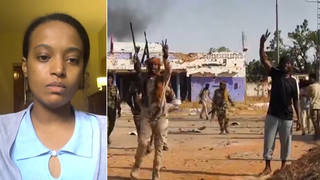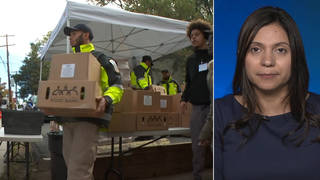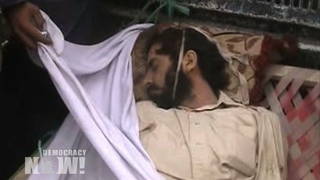
Guests
- Sarah Knuckeyprofessor at New York University School of Law and former adviser to the U.N. special rapporteur on extrajudicial executions.
- James Cavallarodirector of the International Human Rights and Conflict Resolution Clinic at Stanford University.
A new report on the secret U.S. drone war in Pakistan says the attacks have killed far more civilians than acknowledged, traumatized a nation and undermined international law. In “Living Under Drones,” researchers conclude the drone strikes “terrorize men, women, and children, giving rise to anxiety and psychological trauma among civilian communities.” The study concludes that most of the militants killed in the strikes have been low-level targets whose deaths have failed to make the United States any safer. Just 2 percent of drone attack victims are said to be top militant leaders. We’re joined by report authors James Cavallaro, director of the International Human Rights and Conflict Resolution Clinic at Stanford University, and Sarah Knuckey, professor at New York University School of Law and former adviser to the U.N. special rapporteur on extrajudicial executions. [includes rush transcript]
Transcript
NERMEEN SHAIKH: We turn now to the Obama administration’s secret overseas drone war.
PRESIDENT BARACK OBAMA: I want to make sure that people understand, actually, drones have not caused a huge number of civilian casualties. For the most part, they have been very precise precision strikes against al-Qaeda and their affiliates. And we are very careful in terms of how it’s been applied. So, I think that there’s this perception somehow that we’re just sending in a whole bunch of strikes willy-nilly. This is a targeted, focused effort at people who are on a list of active terrorists who are trying to go in and harm Americans, hit American facilities, American bases, and so on. It is important for everybody to understand that this thing is kept on a very tight leash.
NERMEEN SHAIKH: That was President Obama speaking earlier this year defending his administration’s use of drones, which have been used to carry out assassinations in Pakistan, Afghanistan, Yemen and Somalia. While the administration has repeatedly defended the program, a new joint report by the Stanford and New York University law schools on the use of drones in Pakistan reveal the strikes have killed far more civilians than American officials have previously acknowledged. In addition, the study says the drones have alienated the Pakistani public and undermined international law. The new report is called “Living Under Drones: Death, Injury, and Trauma to Civilians from US Drone Practices in Pakistan.” This is an interview the researchers did with one of the survivors of a drone attack.
DRONE ATTACK SURVIVOR: [translated] It was Ramadan. We were about to break our fast with the children. We took a bite, said our prayers. The children had just started eating when the missile struck. My two sons and I were outside, but everyone inside was killed. Three people were killed: my brother, my brother’s son and my brother-in-law.
NERMEEN SHAIKH: The report also examined the underreported psychological impact of drone warfare on the local community in the Pakistani area of Waziristan. The report says the drone strikes, quote, “terrorize men, women, and children, giving rise to anxiety and psychological trauma among civilian communities. Those living under drones have to face the constant worry that a deadly strike may be fired at any moment, and the knowledge that they are powerless to protect themselves.” A local from Waziristan explained the psychological terror caused by drones.
WAZIRISTAN LOCAL 1: [translated] The drones are having a really bad effect on this area. Everyone is under so much psychological pressure that many have to go to the city to see a doctor.
AMY GOODMAN: The new drone study concludes most of the militants killed in the strikes have been low-level targets whose deaths have failed to make the United States any safer. Just 2 percent of drone attack victims are said to be top militant leaders.
Well, for more, we’re joined by two of the authors of the report. In Stanford, California, we’re joined by James Cavallaro. He is the director of the International Human Rights and Conflict Resolution Clinic at Stanford University, as well as a Standford law professor. And here in New York, we’re joined by Sarah Knuckey. She is a professor at New York University’s law school. She’s the former adviser to the U.N. special rapporteur on extrajudicial executions.
We welcome you both to Democracy Now! Professor Knuckey, let’s start with you, why you did this drone report, to begin with, and what you found going over.
SARAH KNUCKEY: The dominant narrative that we receive from the U.S. government and in most mainstream media accounts is that drones are surgically precise and effective toward securing U.S. safety. We wanted to go to Pakistan and speak with people who live in the areas where drones fly frequently, with medical doctors, with psychiatrists, with journalists and humanitarian workers that work in North Waziristan, to ask them how and if the drones are impacting their lives.
What we found, much to our surprise, was, first of all, that there is significant evidence of civilian casualties. Most reliable evidence indicates between 400 and 800 civilian casualties since 2004. Second, that more than the deaths and injuries to civilians, there’s broad mental health impacts for people. They are unable to protect themselves from the drones, which fly 24 hours a day. Because the drones are very precise, in a certain sense, you never know whether it might hit your vehicle or your home or your child’s school. Even the medical doctors and journalists felt, even though they knew they were safer than most civilians, that they felt unable to go about their daily lives without a constant sense of fear. Because of that fear, people change their daily practices in really important ways. Medical doctors will not go to a drone strike zone within six hours, because they fear being themselves struck in a secondary strike. Journalists and medical doctors, when they go to the market, when they drive their car, they feel this fear. Some parents admitted—and they were embarrassed to admit this, but they admitted that they wouldn’t send their children to school at certain times, because they were worried about strikes. The jurga, which is an extremely important community mechanism for resolving disputes—there was a significant strike on a jurga. Those people said they had the jurga in a public place because they felt safe, they knew they were civilian. But they were hit, and so now people are afraid to meet in public spaces to resolve disputes.
NERMEEN SHAIKH: Can you say something, Sarah, about the significance of what are called secondary strikes and how that has prevented people, like medics and so on, going to areas where strikes have already occurred?
SARAH KNUCKEY: There’s now significant evidence of what are called “double tap” or secondary or third strikes, where there will be a first strike on a target—a vehicle, perhaps, or a home—and then when further people come to the area of that strike, there will be a second strike upon those that have come to rescue them or to assist those who have been victimized. It’s because of this that we were told by humanitarian organizations that they don’t attend to drone strike areas within six hours, to prevent risk to their staff.
AMY GOODMAN: Over the summer, the U.N.'s top human rights official, Navi Pillay, raised concerns about the drones' legality while speaking before the U.N. Human Rights Council.
NAVI PILLAY: It is unclear that all persons targeted are combatant or directly participating in hostilities. I remind states of their international obligation to take all necessary precautions to ensure that the use of drones comply with international law. I urge them to conduct investigations that are transparent, credible and independent and to provide victims with effective remedies.
AMY GOODMAN: Professor Sarah Knuckey, your response to Navi Pillay?
SARAH KNUCKEY: It’s very difficult to have a serious, in-depth legal conversation here, because we’re essentially operating in an information black hole. For years, the U.S. government has refused to provide any information. The U.N. has been making calls for accountability and transparency since at least 2003 with respect to drone strikes. The U.S. government won’t release even the Department of Justice legal memoranda, which explain the legal basis for the strikes. There have been, within the last two years, a small number of very short speeches by government officials which explain the legal basis. Civil society, both domestic and internationally, have been calling for years for the U.S. government to explain how it is that these strikes are lawful, and it so far has refused to do so with the depth that we need.
In addition, there are particular practices which cause significant concern from an international law perspective. This concerns especially the double strikes that we mentioned earlier. It also concerns so-called “signature strikes,” where strikes are carried out not on a known, named target, but on a person based on a pattern of behavior or life analysis. We don’t know what criteria those strikes are carried out. And because of the large numbers of civilian casualties that have been recorded, there’s a concern about whether strikes are complying with appropriate precautions in attack, as well as discrimination between terrorists or militants and civilians.
NERMEEN SHAIKH: I want to bring in James Cavallaro into the conversation, the co-author of the report at Stanford University Law School. James, can you elaborate a little about the places you went to in Pakistan, the people, the number of people you spoke with, and what most surprised you, compared to other reports, for example, that have come out on drone attacks and their implications?
JAMES CAVALLARO: Well, we took two research trips to Pakistan for a significant number of days each time, and we were able to meet with about 70 individuals who had experienced drones and their very negative effects in a direct way. So, these were people either who had been struck by drones themselves or had been maimed, seriously injured, or people who had lost a close relative—a son, a brother, an uncle or more, as in the video we saw a bit earlier—or they were people who lived under the constant presence of drones. We also, of course, did online research, books, spoke with experts, spoke with journalists, spoke with analysts, gathered as much information as we possibly could, went through all the strike data aggregators, so that we could see and cross-reference information and find out what was going on. But what we were able to do, which is exceptionally difficult in Pakistan, was to speak with people who have direct life experience of living in communities in which drones hover 24 hours a day.
Now, you’ve already mentioned the misinformation that unfortunately has been the dominant narrative of the administration regarding the number of civilian casualties. So, one finding that we were able to include in the report is that the narrative of no civilian casualties or almost no civilian casualties is simply false.
But above and beyond that, what we found—and this was something that really affected us and was something that we tried to make as clear as possible in the report—is that apart from the deaths and the maimings and the injuries, apart from that, there is a constant effect that people who live in these areas of northwest Pakistan—there are experiences, there are effects that are quite serious that everyone in the community—men, women, children, anyone and everyone—feel and experience on an everyday basis. Drones flying overhead, they make a buzzing sound. If you’re under those drones, you know, as Sarah said earlier, that they can fire down at any time, and they can fire down on anyone. And if you are within strike distance in the blast radius of a strike, it doesn’t matter that they’re not striking you. You—shrapnel and the blast of drones and, in particular, of the Hellfire missiles that they fire, they don’t discriminate. Maybe the operators discriminate—and again, how they discriminate is an open question, and we can talk about that. But once the missiles hit, those within a radius of danger are subject to death or serious injury. And so, the consequence of this are the psychological effects and also significant effects on Pakistani society, on local society. People are afraid to congregate in groups of three or four. People don’t go to rescue maybe close relatives or friends when a drone missile has struck. People don’t go to funerals of community members that they would go to funerals of. In short, there’s a breakdown in basic social engagement that we’ve documented, and what it adds up to is thousands of people living in a region where drones cause them to experience life as though they were in a war zone. And the last time I checked, the United States had not declared war on Pakistan.
AMY GOODMAN: I want to go to another clip of an interview you did in Waziristan of a local resident discussing his views of the drones.
WAZIRISTAN LOCAL 2: [translated] We don’t know why there are drone attacks in our area. But it’s Americans doing this, to end the lives of Muslims.
WAZIRISTAN LOCAL 1: [translated] It is our plea that the drone attacks upon us be stopped, because the American government is oppressing us without reason.
AMY GOODMAN: And now let’s go to President Obama. Earlier this month, he publicly disclosed what he says are his administration’s criteria for carrying out drone strikes and targeted assassinations abroad. He was speaking on CNN in some of his most extensive comments on the drone attacks to date.
PRESIDENT BARACK OBAMA: It has to be a target that is authorized by our laws. It has to be a threat that is serious and not speculative. It has to be a situation in which we can’t capture the individual before they move forward on some sort of operational plot against the United States. And this is an example of where I think there’s been some misreporting. Our preference is always to capture if we can, because we can gather intelligence. But a lot of the terrorist networks that target the United States, the most dangerous ones, operate in very remote regions, and it’s very difficult to capture them. And we’ve got to make sure that in whatever operations we conduct, you know, we are very careful about avoiding civilian casualties.
AMY GOODMAN: Those are President Obama’s comments days after at least 11 civilians were killed in a U.S. drone strike in Yemen, including three children. Professor James Cavallaro at Stanford Law School, can you respond to what President Obama said in that CNN interview with Jessica Yellin?
JAMES CAVALLARO: Well, first, one of the biggest issues—and Sarah has highlighted this—is that what President Obama and the administration are asking us to do is to trust them: “We’re doing this very carefully. We’re not going to tell you the precise criteria. We’re not going to tell you who we’ve killed. We’re not going to provide that information. We’re even going to deny for months and years that this program exists. But trust us, we’re following all the rules.” So, as a citizen, as someone who believes in democracy and democratic accountability, that concerns me, one.
Two, the criteria that the president mentions are ones all of which must be complied with in order for a strike to be legal, and we have significant evidence demonstrating that there is reason to doubt that those criteria had been met. So, he mentions, for instance, that there must be an imminent threat that’s posed. Well, we know, for instance, that there have been people who have been on lists to be killed for periods that go on at times for days and weeks and months. So, how is it that a person poses an imminent threat over a period of months, and there’s no opportunity to capture that person?
But I think perhaps the most damning bit of evidence here is, most of the focus and, in the first clip that you played, the discussion centers on which individuals are placed on target lists, and I think that diverts attention from where, unfortunately, most of the killing has occurred, which is in the signature strikes. So, let me go to the numbers. Something on the order of 2 percent of those who have been killed have been identified as, quote-unquote, “high-value” targets, which means that 98 percent are not. So those who are being killed on a routine basis, unfortunately, are either low-level combatants or civilians. And what are the criteria for those strikes? And here’s the answer: it’s a pattern of life. It’s what a drone operator in Creech, Nevada, or in Langley, Virginia, or wherever that person may be—and we’re only speculating—sees on a video screen and what he or she believes constitutes activity that is a threat to the United States, an imminent threat, in a situation where a person cannot be arrested, etc. That’s the basis. But that basis has not been made express. And that basis, we know from the results, has led to many civilian deaths. So, we’ve got a lot of reason to question what the president has said and a lot of reason to question that laws are being complied with. That’s why one of our principal recommendations-slash-requests is that all the information that’s available be provided.
And finally—this is something that I think has to be emphasized and cannot be emphasized enough—the New York Times reported—and I have not heard the administration deny this in a way that’s credible—so the New York Times reported in May of this year that the administration considers that all adult males killed in drone strikes are combatants. Now think about that for a minute. What it authorizes authorities to do is to kill first, knowing that afterwards whoever is killed will be termed a combatant, unless there is posthumous evidence of that person’s innocence. I think that fact, which is extraordinarily damning, helps to explain the unreal numbers that the government has been churning and issuing to us for months and years. But it’s a fact that ought to cause us very, very significant concern as citizens of the United States and as people who are concerned about what the most powerful government in the world is doing.
NERMEEN SHAIKH: Sarah Knuckey, in addition to what James has said you concluded in the report, people who defend drone strikes do so on the basis that they are—as, again, what James said—they get high-value targets with minimal civilian casualties. Of course, this is not what you find in your report. But you also conclude in the report that U.S. strikes have facilitated recruitment to violent, non-state armed groups like al-Qaeda, etc., and motivated further violent attacks. Can you elaborate on that?
SARAH KNUCKEY: One of the things we found is, first of all, the strikes are extraordinarily unpopular in Pakistan. Only 17 percent of people support them. So, quantitative polling shows clearly that some 75 percent of Pakistanis now consider the United States an enemy. The drone strikes have increased resentment towards this government.
NERMEEN SHAIKH: Pakistan, which is supposed to be one of the key allies of the U.S. in the war on terror.
SARAH KNUCKEY: What we also found through interviews was that a number of people said that they wanted revenge, that their family members were killed, there would be blood for blood, and that the injuries and deaths that they had suffered made them, as you would expect, extremely angry towards the United States government. And a number of professional people we interviewed also stated that they had known people motivated to join the Taliban in Afghanistan to fight against U.S. forces because of their anger about particular drone strikes.
AMY GOODMAN: Finally, I wanted to ask you, Sarah Knuckey, about international law and the message this sends to other countries. This news is just out today, that Iran has unveiled what it says is a new indigenous long-range unmanned drone capable of flying over most of the Middle East. The Shahed 129 has a range of 1,240 miles and could be equipped with bombs and missiles, according to the Islamic Revolution Guards Corps.
SARAH KNUCKEY: Iran is one of an estimated 76 countries who now are developing or have drone technology. At the moment, U.S. exports have been fairly restricted because of export controls, although some government officials in the United States, as well as drone manufacturers, have been working very hard the last couple of years to reduce those export controls. The Pentagon, it was just announced, released information that some 66 countries would now be given permission to purchase drones from United States manufacturers. The proliferation, we’ve been tracking it over the last couple of years, and it’s increased rapidly. The concerns from it are obvious.
NERMEEN SHAIKH: But no other country uses drones to carry out strikes, though, right? They’re used mostly for surveillance?
SARAH KNUCKEY: There’s only been one unconfirmed report of another country carrying out a targeted killing via drone strike, and that was a reported strike in Egypt, reportedly by Israel.
AMY GOODMAN: And when was that?
SARAH KNUCKEY: This year.
AMY GOODMAN: Well, we’re going to leave it there. I want to thank you, Sarah Knuckey, an NYU Law School professor, former adviser to the U.N. special rapporteur on extrajudicial executions, co-authored the new report, “Living Under Drones: Death, Injury, and Trauma to Civilians from US Drone Practices in Pakistan.” The co-author of that report, James Cavallaro, the director of the International Human Rights and Conflict Resolution Clinic at Stanford University, a Stanford law professor. Thanks so much, both, for joining us. And we’ll link to your report at democracynow.org. We’ll be back in a minute.












Media Options